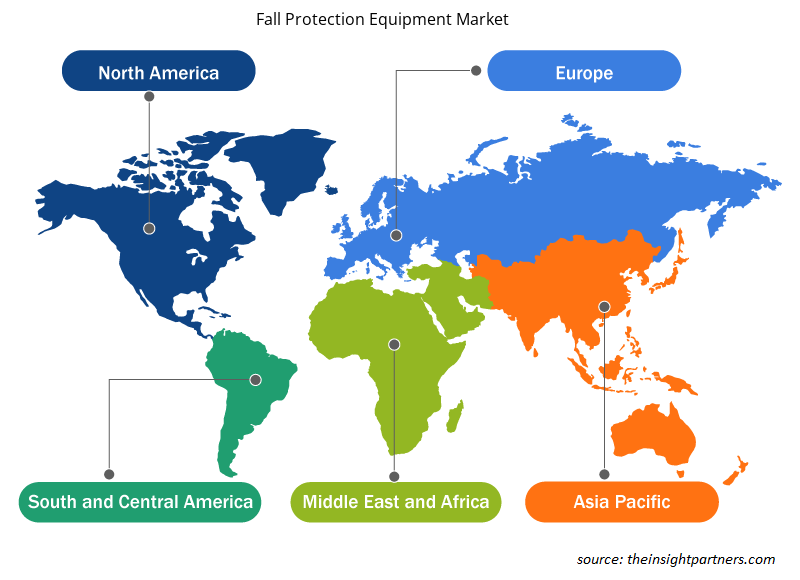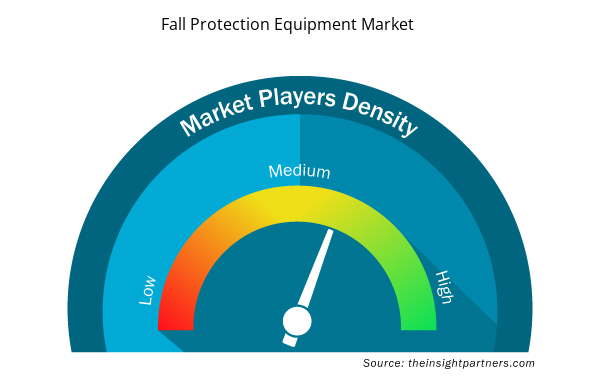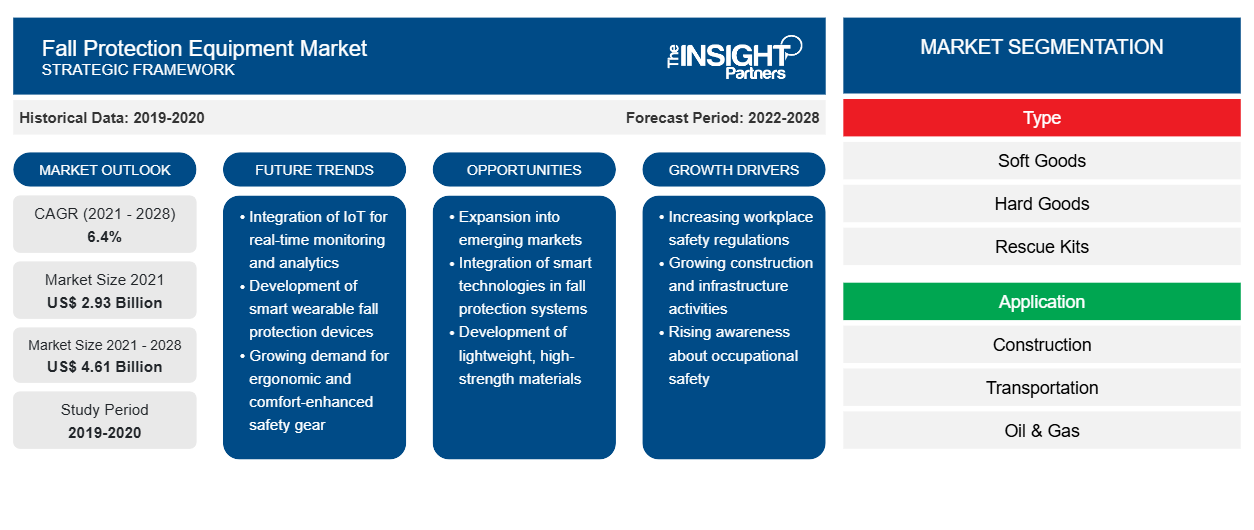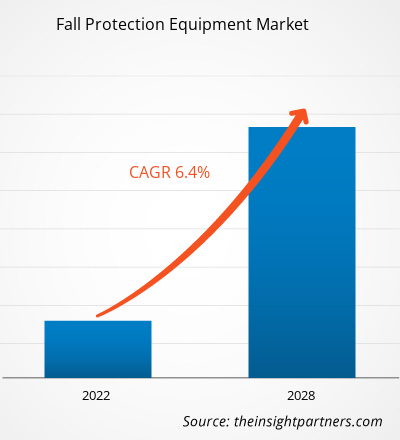落下防止装置市場は、2021年の29億3,486万米ドルから2028年には46億661万米ドルに成長すると予想されており、2021年から2028年にかけて6.4%のCAGRで成長すると予測されています。
先進国と発展途上国における急速な工業化は、市場の拡大を牽引する主な要因の 1 つです。さまざまな製造、採鉱、その他の産業現場で適切な安全手順が欠如しているため、職業上の危険がますます蔓延しています。他の国と比較して、米国は労働者の安全と健康をより懸念しており、それが国内での落下防止装置の採用を促進しています。安全基準と手順を監督するために、米国は労働安全衛生局 (OSHA) や米国規格協会 (ANSI) などの特定の機関を設立しました。OSHA は、職場でのさまざまな職業に関連する OSHA 規制と基準に関する 10 時間および 30 時間の意識向上トレーニングを労働者に提供する、健康と安全の規制およびコンプライアンス組織です。ただし、職場での安全慣行への関心の高まりと、ヨーロッパとアジアでの労働者の安全に関する政府規制の改善が市場を牽引しています。人口増加により、インドや中国などのアジア諸国での建設活動の増加と石油およびガス部門の成長が、予測期間中の市場の成長を促進すると予想されます。都市化の進展と石油・ガス産業の成長は、MEA(中東・アフリカ)およびSAM(南米)地域における落下防止装置市場の成長を支える主な要因の一つです。
要件に合わせてレポートをカスタマイズする
このレポートの一部、国レベルの分析、Excelデータパックなど、あらゆるレポートを無料でカスタマイズできます。また、スタートアップや大学向けのお得なオファーや割引もご利用いただけます。
- このレポートの主要な市場動向を入手してください。この無料サンプルには、市場動向から見積もりや予測に至るまでのデータ分析が含まれます。
COVID-19パンデミックが墜落防止装置市場に与える影響
COVID-19の流行は、2021年も多くの国で悪影響を及ぼし続けています。生産工場の閉鎖や事業活動の制限、ロックダウンや移動制限により、墜落防止装置の生産とサプライチェーンが妨げられています。墜落防止装置の継続的な需要は、政府によるロックダウンと建設プロジェクトの少なさにより、2020年にはわずかに減少しました。しかし、2021年には、建設活動、石油・ガス探査、通信プロジェクトの増加により、従業員の安全を確保するための墜落防止装置の需要があります。eコマースビジネスも、建設分野での墜落防止装置の需要を高めるのに貢献しています。
落下防止装置市場の洞察
建設活動の増加
世界中で建設活動が増加していることが、落下防止装置市場を牽引する主な要因です。インドや中国などのアジア諸国では人口が急増しており、これらの国では商業および住宅スペースの需要が絶えず拡大しています。現在、世界経済は、世界中の経済が発展の野望を達成できない原因となっている信用制約の拡大により、深刻な減速を経験しています。インフラは、現在の状況において、経済を金融混乱から救う万能の力を持つと考えられているため、発展格差に対処するための主要な優先事項であり続けています。世界中の政府は、雇用を創出することで製品やサービスの需要を高めるために、物理的および社会的インフラに資金を投入しています。
タイプベースの市場分析
タイプに基づいて、落下防止装置市場は、ソフトグッズ、ハードグッズ、救助キット、ボディベルト、フルボディハーネス、その他に分類されます。ハードグッズセグメントは、安全性の向上を提供するため、主要なセグメントです。さらに、このセグメントの革新の高まりは、市場の成長を促進すると予想されています。しかし、すべての産業ユーザーからのフルボディハーネスシステムの需要の増加は、このセグメントが最高のCAGRで成長するのに役立っています。
アプリケーションベースの市場分析
用途別に見ると、落下防止装置市場は建設、石油・ガス、運輸、エネルギー・公益事業、通信に分かれています。各業界では、活動の効率的な流れを確保し、労働者の安全を維持するために、施設内に落下防止装置が必要です。2020年には、建設部門が最大の市場シェアを占めました。
落下防止装置市場で活動する企業は、市場での地位を維持するために、合併、買収、市場イニシアチブなどの戦略を採用しています。主要企業によるいくつかの開発を以下に示します。
- 2021 年 5 月、Pure Safety Group は高所安全ブランド ファミリー (Stronghold by PSG、Ty-Flt、Checkmate、HART) を Guardian ブランドに統合しました。この拡張により、Guardian は世界最大の独立落下防止および防止ブランドになりました。PSG, Ty-Flt, Checkmate, and HART—under the Guardian banner. This expansion has now made Guardian the world’s largest independent fall protection and prevention brand.
- 3M Fall Protection は、2021 年 3 月末までに、すべての ANSI および CSA 認定の 3M DBI SALA ハーネスにサスペンション トラウマ セーフティ ストラップを発明し、組み込むようになりました。CSA certified 3M DBI SALA harnesses by the end of March 2021.
落下防止装置市場の地域別洞察
予測期間を通じて落下防止装置市場に影響を与える地域的な傾向と要因は、Insight Partners のアナリストによって徹底的に説明されています。このセクションでは、北米、ヨーロッパ、アジア太平洋、中東、アフリカ、南米、中米にわたる落下防止装置市場のセグメントと地理についても説明します。

- 墜落防止装置市場の地域別データを入手
落下防止装置市場レポートの範囲
| レポート属性 | 詳細 |
|---|---|
| 2021年の市場規模 | 29億3千万米ドル |
| 2028年までの市場規模 | 46億1000万米ドル |
| 世界のCAGR(2021年~2028年) | 6.4% |
| 履歴データ | 2019-2020 |
| 予測期間 | 2022-2028 |
| 対象セグメント | タイプ別
|
| 対象地域と国 | 北米
|
| 市場リーダーと主要企業プロフィール |
|
市場プレーヤーの密度:ビジネスダイナミクスへの影響を理解する
落下防止装置市場は、消費者の嗜好の変化、技術の進歩、製品の利点に対する認識の高まりなどの要因により、エンドユーザーの需要が高まり、急速に成長しています。需要が高まるにつれて、企業は提供品を拡大し、消費者のニーズを満たすために革新し、新たなトレンドを活用し、市場の成長をさらに促進しています。
市場プレーヤー密度とは、特定の市場または業界内で活動している企業または会社の分布を指します。これは、特定の市場スペースに、その規模または総市場価値と比較して、どれだけの競合相手 (市場プレーヤー) が存在するかを示します。
墜落防止装置市場で事業を展開している主要企業は次のとおりです。
- 3M
- フォールテック
- フレンチクリークプロダクション
- 最前線
- ガーディアン落下防止
免責事項:上記の企業は、特定の順序でランク付けされていません。

- 落下防止装置市場のトップキープレーヤーの概要を入手
世界の落下防止装置市場は以下のように区分されています。
タイプ別
- ソフトグッズ
- ハードグッズ
- 救助キット
- ボディベルト
- フルボディハーネス
- その他
アプリケーション別
- 工事
- 交通機関
- 石油とガス
- 鉱業
- エネルギーと公共事業
- 通信
- その他
地理別
北米
- 私たち
- カナダ
- メキシコ
ヨーロッパ
- フランス
- ドイツ
- イタリア
- 英国
- ロシア
- その他のヨーロッパ
アジア太平洋(APAC)
- 中国
- インド
- 韓国
- 日本
- オーストラリア
- その他のアジア太平洋地域
中東・アフリカ(MEA)
- 南アフリカ
- サウジアラビア
- アラブ首長国連邦
- MEAの残り
南アメリカ(SAM)
- ブラジル
- アルゼンチン
- SAMの残り
企業プロフィール
- 3M
- フォールテック
- フレンチクリークプロダクション
- 最前線
- ガーディアン落下防止
- 安全を守る
- クイックセーフティ
- MSAセーフティ株式会社
- ハネウェルインターナショナル株式会社
- トライテック落下防止
- 過去2年間の分析、基準年、CAGRによる予測(7年間)
- PEST分析とSWOT分析
- 市場規模価値/数量 - 世界、地域、国
- 業界と競争環境
- Excel データセット



Report Coverage
Revenue forecast, Company Analysis, Industry landscape, Growth factors, and Trends

Segment Covered
This text is related
to segments covered.

Regional Scope
North America, Europe, Asia Pacific, Middle East & Africa, South & Central America

Country Scope
This text is related
to country scope.
よくある質問
3M; Falltech; French Creek Production; Frontline; Gravitec Systems, Inc.; Guardian Fall (Pure Safety Group, Inc.); Honeywell International Inc; Kwiksafety; Kee Safety, Inc; and Msa are the key companies in the fall protection equipment market.
APAC led the global fall protection equipment market with the highest growth rate in 2020, followed by North America and Europe. In the coming years, the market in Asia would witness a massive growth in demand for fall protection equipment, owing to the rise in population of countries in the region, coupled with various government initiatives to attract private investments in construction and infrastructure development. Moreover, the surging number of commercial and industrial end users is inclined to use fall protection equipment to keep their workers safe from hazards.
The construction segment led the fall protection equipment market globally with a highest market share in the year 2020 and is expected to continue its dominance during the forecast period till 2028. The construction sector is the most common end user of fall prevention systems, as it has the highest annual injury rate. The global construction sector is responsible for more than a third of all workplace deaths each year. Due to a large number of planned building projects, the US is one of the most important countries for safety equipment on construction sites. As mandated by administrations in several states across the US, the use of fall protection systems to reduce the number of accidents and fatalities during building activities is expected to fuel the growth of this market. The US country is one of the major construction industry markets, with a spending worth of ~1.5 trillion in June 2021. Recent advancements in construction technologies and rising demand for worker safety solutions have driven the market growth. However, the shutdown of construction projects and delayed residential projects investments due to the COVID - 19 pandemic has severely impacted the market growth as the demand for fall protection equipment has been lowered.
The fall protection equipment market by product type was led by hard goods which held a market share of 36.8% in the year 2020 and is anticipated to continue its dominance during the forecast period to account for 37.8% share of the fall protection equipment market by the year 2028. The development of hard good (those made from metal or other non-synthetic materials) fall equipment is focused on adaptability and efficiency. Anchors, carabiners, rope grabs, and retractable blocks are examples of hard goods. Anchors are extremely capable of supporting intended weights and assisting in the prevention of falls. The use of hard goods is important in the mining sector since it increases worker flexibility and convenience. The growth of the mining sector in the US is expected to boost the demand for these products. Rope grabs are the ideal alternative for vertical and horizontal lifeline systems used in construction and mining industries because they enable level and inertial locking to prevent the fall. Today's hard goods have various capacities, and they reduce the amount of equipment required at the workplace. Self-retracting lifelines with a built-in rescue system are a newer addition. Depending on the surroundings, these devices, which may be programmed to automatically lower a worker in the event of a fall, can obviate the need for a separate rescue system on site.
With the rising speed and progress of structure and building design, the problems and hazards associated with it are also increasing. To maintain safety requirements, the safety equipment must also be upgraded over time. As a result of changing patterns, governments across the world have revised their fall protection requirements. Current fall prevention equipment has undergone adjustments as a result of the revised standard. The standard mandates that gate strength requirements for snap hooks and carabiners be doubled to 3,600 pounds in all directions of possible loading. The old ANSI standard demanded 220 pounds on the gate's face and 350 pounds on the gate's side, even though many manufacturers were already fulfilling the new standard's criteria when it was approved. To optimize fall arrest, harnesses must now include D-rings in the front and rear, and twin-leg lanyards must be tested before use and have cautions on product labels on how to use them appropriately. As a result, fall protection equipment suppliers will see creating adjustable fall protection equipment as a prime opportunity.
The rise in construction activities around the world is a primary element driving the fall protection equipment market. As Asian countries such as India and China are witnessing significant population growth, the demand for commercial and residential spaces in these countries is constantly expanding. The global economy is currently experiencing a severe slowdown due to a developing credit constraint that is causing economies around the world to miss their developmental ambitions. Infrastructure remains a major priority for addressing developmental gaps in the current scenario, as it is seen as omnipotent and capable of bringing economies out of financial upheaval. Governments all over the world are pumping money into physical and social infrastructure to increase the demand for products and services by creating jobs. During COVID, Construction is more important than ever in this difficult time. The sector has played a crucial role in responding to the crisis and in the recovery, from erecting hospitals in a matter of days to giving lifesaving equipment. The construction industry accounts for 13% of global GDP, and the increasing worker availability could assist recovery while tackling the most pressing issues. Despite challenges in 2020, the oil industry is finally starting to recover. As a consequence, the economy is boosting. The aforementioned factors are expected to fuel the need for fall protection equipment worldwide.
Trends and growth analysis reports related to Manufacturing and Construction : READ MORE..
The List of companies - Fall Protection Equipment Market
- 3M
- Falltech
- French Creek Production
- Frontline
- Guardian Fall Protection
- Kee Safety
- KwikSafety
- MSA Safety Incorporated
- Honeywell International Inc.
- Tritech Fall Protection
The Insight Partners performs research in 4 major stages: Data Collection & Secondary Research, Primary Research, Data Analysis and Data Triangulation & Final Review.
- Data Collection and Secondary Research:
As a market research and consulting firm operating from a decade, we have published and advised several client across the globe. First step for any study will start with an assessment of currently available data and insights from existing reports. Further, historical and current market information is collected from Investor Presentations, Annual Reports, SEC Filings, etc., and other information related to company’s performance and market positioning are gathered from Paid Databases (Factiva, Hoovers, and Reuters) and various other publications available in public domain.
Several associations trade associates, technical forums, institutes, societies and organization are accessed to gain technical as well as market related insights through their publications such as research papers, blogs and press releases related to the studies are referred to get cues about the market. Further, white papers, journals, magazines, and other news articles published in last 3 years are scrutinized and analyzed to understand the current market trends.
- Primary Research:
The primarily interview analysis comprise of data obtained from industry participants interview and answers to survey questions gathered by in-house primary team.
For primary research, interviews are conducted with industry experts/CEOs/Marketing Managers/VPs/Subject Matter Experts from both demand and supply side to get a 360-degree view of the market. The primary team conducts several interviews based on the complexity of the markets to understand the various market trends and dynamics which makes research more credible and precise.
A typical research interview fulfils the following functions:
- Provides first-hand information on the market size, market trends, growth trends, competitive landscape, and outlook
- Validates and strengthens in-house secondary research findings
- Develops the analysis team’s expertise and market understanding
Primary research involves email interactions and telephone interviews for each market, category, segment, and sub-segment across geographies. The participants who typically take part in such a process include, but are not limited to:
- Industry participants: VPs, business development managers, market intelligence managers and national sales managers
- Outside experts: Valuation experts, research analysts and key opinion leaders specializing in the electronics and semiconductor industry.
Below is the breakup of our primary respondents by company, designation, and region:

Once we receive the confirmation from primary research sources or primary respondents, we finalize the base year market estimation and forecast the data as per the macroeconomic and microeconomic factors assessed during data collection.
- Data Analysis:
Once data is validated through both secondary as well as primary respondents, we finalize the market estimations by hypothesis formulation and factor analysis at regional and country level.
- Macro-Economic Factor Analysis:
We analyse macroeconomic indicators such the gross domestic product (GDP), increase in the demand for goods and services across industries, technological advancement, regional economic growth, governmental policies, the influence of COVID-19, PEST analysis, and other aspects. This analysis aids in setting benchmarks for various nations/regions and approximating market splits. Additionally, the general trend of the aforementioned components aid in determining the market's development possibilities.
- Country Level Data:
Various factors that are especially aligned to the country are taken into account to determine the market size for a certain area and country, including the presence of vendors, such as headquarters and offices, the country's GDP, demand patterns, and industry growth. To comprehend the market dynamics for the nation, a number of growth variables, inhibitors, application areas, and current market trends are researched. The aforementioned elements aid in determining the country's overall market's growth potential.
- Company Profile:
The “Table of Contents” is formulated by listing and analyzing more than 25 - 30 companies operating in the market ecosystem across geographies. However, we profile only 10 companies as a standard practice in our syndicate reports. These 10 companies comprise leading, emerging, and regional players. Nonetheless, our analysis is not restricted to the 10 listed companies, we also analyze other companies present in the market to develop a holistic view and understand the prevailing trends. The “Company Profiles” section in the report covers key facts, business description, products & services, financial information, SWOT analysis, and key developments. The financial information presented is extracted from the annual reports and official documents of the publicly listed companies. Upon collecting the information for the sections of respective companies, we verify them via various primary sources and then compile the data in respective company profiles. The company level information helps us in deriving the base number as well as in forecasting the market size.
- Developing Base Number:
Aggregation of sales statistics (2020-2022) and macro-economic factor, and other secondary and primary research insights are utilized to arrive at base number and related market shares for 2022. The data gaps are identified in this step and relevant market data is analyzed, collected from paid primary interviews or databases. On finalizing the base year market size, forecasts are developed on the basis of macro-economic, industry and market growth factors and company level analysis.
- Data Triangulation and Final Review:
The market findings and base year market size calculations are validated from supply as well as demand side. Demand side validations are based on macro-economic factor analysis and benchmarks for respective regions and countries. In case of supply side validations, revenues of major companies are estimated (in case not available) based on industry benchmark, approximate number of employees, product portfolio, and primary interviews revenues are gathered. Further revenue from target product/service segment is assessed to avoid overshooting of market statistics. In case of heavy deviations between supply and demand side values, all thes steps are repeated to achieve synchronization.
We follow an iterative model, wherein we share our research findings with Subject Matter Experts (SME’s) and Key Opinion Leaders (KOLs) until consensus view of the market is not formulated – this model negates any drastic deviation in the opinions of experts. Only validated and universally acceptable research findings are quoted in our reports.
We have important check points that we use to validate our research findings – which we call – data triangulation, where we validate the information, we generate from secondary sources with primary interviews and then we re-validate with our internal data bases and Subject matter experts. This comprehensive model enables us to deliver high quality, reliable data in shortest possible time.


 このレポートの無料サンプルを入手する
このレポートの無料サンプルを入手する